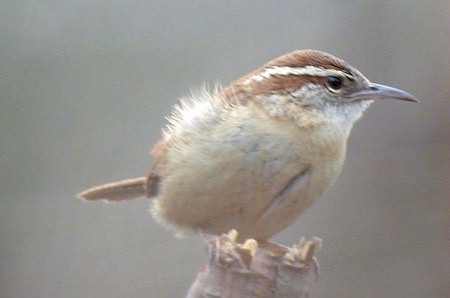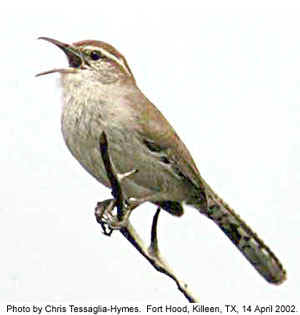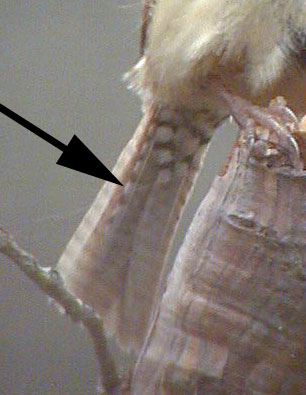
 Comparisons of the tails of
Carolina Wrens (Thryothorus ludovicianus) and Bewick's Wren (Thryomanes
bewickii).
Comparisons of the tails of
Carolina Wrens (Thryothorus ludovicianus) and Bewick's Wren (Thryomanes
bewickii).
 Comparisons of the tails of
Carolina Wrens (Thryothorus ludovicianus) and Bewick's Wren (Thryomanes
bewickii).
Comparisons of the tails of
Carolina Wrens (Thryothorus ludovicianus) and Bewick's Wren (Thryomanes
bewickii).
Is a little white enough?
All photos © Kevin J. McGowan, except where noted.
Recent confusion concerning a possible Bewick's Wren in New York has brought to light the fact that most birders are unfamiliar with the pattern of markings on the tail feathers of Carolina Wren. Eastern birders rarely get the opportunity to become familiar with Bewick's Wren, unfortunately, and knowing if you have seen the right field mark can be tricky.
Carolina and Bewick's wrens are somewhat similar in appearance: both have unstriped backs, clear chests and bellies, and a large white eyestripe. The standard characters used to distinguish them are that the Carolina Wren is buffy to orange underneath (Bewick's is medium to darkish gray), and the Bewick's Wren has white in the tail. Unfortunately, most field guides do not show the pattern of white in the Bewick's tail very well, and none indicate that Carolina Wren can have white in the tail too. No field guide shows the tail of a Carolina Wren adequately, and people get into trouble when they see the tail too well. The whitish barred areas on the outer tail feathers of the Carolina Wren make people think they are seeing a Bewick's Wren. The mistake is perfectly natural, based on the information most available.
The following photographs were taken of specimens in the Cornell University Museum of Vertebrates Ornithology Collection . Click on the pictures for a larger version.
The tail of a Bewick's Wren has the middle tail feathers brown and barred with black. The others are black with brown barred edges, and the outer several pairs are tipped with whitish gray spots. (Note that these markings are not actually white, but are varying shades of pale gray.) The outer most tail feathers are barred black and whitish gray.
This is a photograph of the tail of a Bewick's Wren (CU 22341, West Virginia, 25 May 1946). Although it is very worn, the basic pattern can be seen.
Note that the inner pair of feathers are lighter than the surrounding ones, and the the largest areas of white are at the tail tips.
The distribution of white in the tail can be seen better from below, where the broad whitish tips are apparent (CU22332, West Virginia, 3 April 1946).
See below for variation.
See below for more examples of variation.
When comparing the tails side by side, the differences and similarities become more obvious. Note that the white on the sides of the outer tail feathers can be striking on both, but that the Bewick's Wren has larger patches, especially at the tips of the feathers (the "corners" of the tail). Notice also that the dark tail of the Bewick's Wren also is proportionately (and absolutely!) longer than the Carolina Wren's lighter-colored tail.
So why don't the field guides show the white on a Carolina Wren's tail? And why, for that matter, have you never noticed it before? The answer is that Carolina Wrens seem to hold their tails mostly furled, and the pale-patterned outer feather is rarely displayed.
Here is a photo of a singing Carolina Wren I took in Ithaca, NY in April 2001. As is pointed out, the feather with the white on it is well hidden from view, even though it at first appears that the outermost tail feather is visible at the edge of the tail. In fact, the apparent "outer" rectrix in this picture looks to be two in from the outermost (r4, not r6).


In normal birding you probably will never be confused because the Carolina Wren hides its white pattern. Oddly enough, it is only when you get too good a look, as when the bird is in the hand, that the confusion arises.
Then, look for any trace of orange on the belly (Carolina), or black in the tail (Bewick's).
More individual variation. Field guides can provide only a few images. Collections are based on the premise that variation happens, and that it is important to capture the range of variation to understand just what the heck you are looking at. Here are a couple of images to show a bit of the range of variation.
Return to the Bad Photos page.
Return to Kevin McGowan's home page.
Go to the Cornell University Museum of Vertebrates Ornithology Collection home page.
Go to the Crow Page.